Stop and Wait Protocol-
Before you go through this article, make sure that you have gone through the previous article on Stop and Wait Protocol.
In stop and wait protocol,
- Sender sends one data packet and then waits for its acknowledgement.
- Sender sends the next packet only after it receives the acknowledgement for the previous packet.
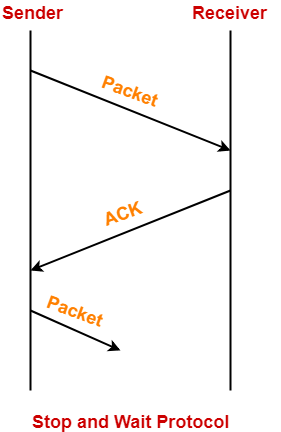
The main problem faced by the Stop and Wait protocol is the occurrence of deadlock due to-
- Loss of data packet
- Loss of acknowledgement
Stop and Wait ARQ-
| Stop and Wait ARQ is an improved and modified version of Stop and Wait protocol. |
Stop and Wait ARQ assumes-
- The communication channel is noisy.
- Errors may get introduced in the data during the transmission.
Working-
- Stop and wait ARQ works similar to stop and wait protocol.
- It provides a solution to all the limitations of stop and wait protocol.
- Stop and wait ARQ includes the following three extra elements.

Thus, we can say-
| Stop and Wait ARQ
= Stop and Wait Protocol + Time Out Timer + Sequence Numbers for Data Packets and Acknowledgements |
Number of Sequence Numbers Required-
NOTEFor any sliding window protocol to work without any problem, the following condition must be satisfied- Available Sequence Numbers >= Sender Window Size + Receiver Window Size |
Stop and wait ARQ is a one bit sliding window protocol where-
- Sender window size = 1
- Receiver window size = 1
Thus, in stop and wait ARQ,
Minimum number of sequence numbers required
= Sender Window Size + Receiver Window Size
= 1 + 1
= 2
Thus,
- Minimum number of sequence numbers required in Stop and Wait ARQ = 2.
- The two sequence numbers used are 0 and 1.
How Stop and Wait ARQ Solves All Problems?
1. Problem of Lost Data Packet-
- Time out timer helps to solve the problem of lost data packet.
- After sending a data packet to the receiver, sender starts the time out timer.
- If the data packet gets acknowledged before the timer expires, sender stops the time out timer.
- If the timer goes off before receiving the acknowledgement, sender retransmits the same data packet.
- After retransmission, sender resets the timer.
- This prevents the occurrence of deadlock.
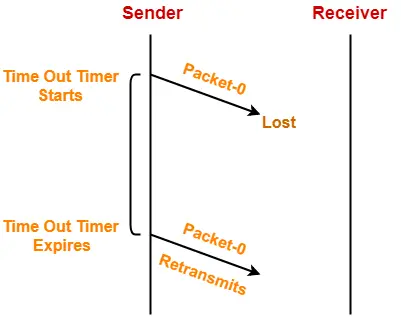
2. Problem of Lost Acknowledgement-
- Sequence number on data packets help to solve the problem of delayed acknowledgement.
- Consider the acknowledgement sent by the receiver gets lost.
- Then, sender retransmits the same data packet after its timer goes off.
- This prevents the occurrence of deadlock.
- The sequence number on the data packet helps the receiver to identify the duplicate data packet.
- Receiver discards the duplicate packet and re-sends the same acknowledgement.
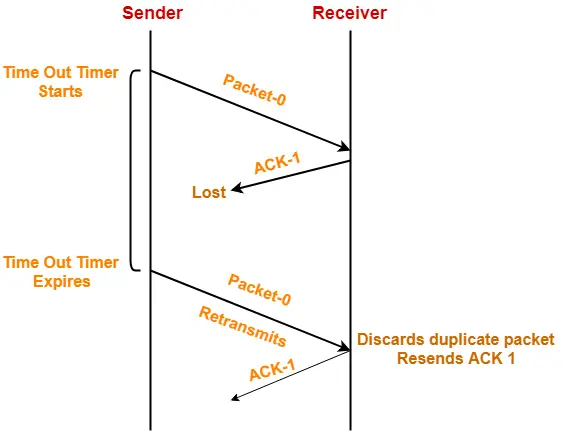
Role of Sequence Number on Data Packets
Consider the above example-
Step-01:
Step-02:
Step-03:
Step-04:
Step-05:
Conclusion-
|
3. Problem of Delayed Acknowledgement-
- Sequence number on acknowledgements help to solve the problem of delayed acknowledgement.
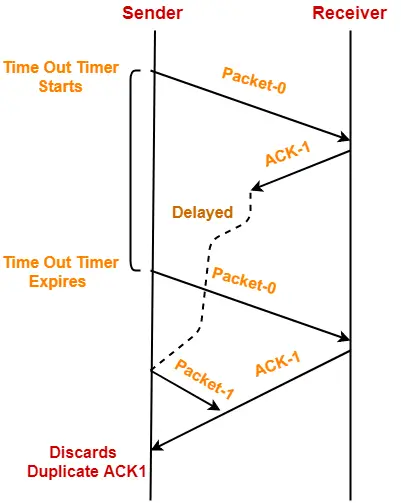
Role of Sequence Number on Acknowledgements
Consider the above example-
Step-01:
Step-02:
Step-03:
Step-04:
Step-05:
Step-06:
Conclusion-
|
4. Problem of Damaged Packet-
- If receiver receives a corrupted data packet from the sender, it sends a negative acknowledgement (NAK) to the sender.
- NAK requests the sender to send the data packet again.
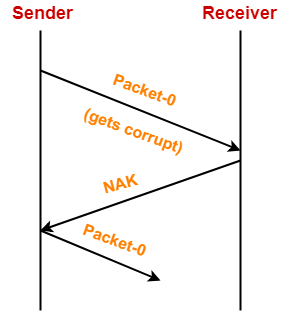
Stop and Wait Protocol Vs Stop and Wait ARQ-
The following comparison table states the differences between the two protocols-
| Stop and Wait Protocol | Stop and Wait ARQ |
| It assumes that the communication channel is perfect and noise free. | It assumes that the communication channel is imperfect and noisy. |
| Data packet sent by the sender can never get corrupt. | Data packet sent by the sender may get corrupt. |
| There is no concept of negative acknowledgements. | A negative acknowledgement is sent by the receiver if the data packet is found to be corrupt. |
| There is no concept of time out timer. | Sender starts the time out timer after sending the data packet. |
| There is no concept of sequence numbers. | Data packets and acknowledgements are numbered using sequence numbers. |
Limitation of Stop and Wait ARQ-
| The major limitation of Stop and Wait ARQ is its very less efficiency. |
To increase the efficiency, protocols like Go back N and Selective Repeat are used.
Explanation-
In stop and wait ARQ,
- Sender window size is 1.
- This allows the sender to keep only one frame unacknowledged.
- So, sender sends one frame and then waits until the sent frame gets acknowledged.
- After receiving the acknowledgement from the receiver, sender sends the next frame.
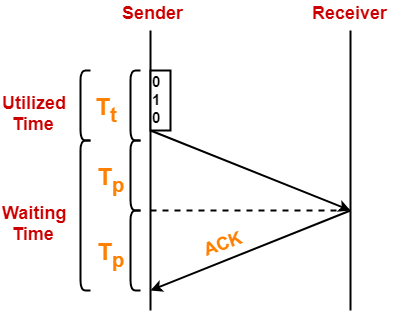
Here,
- Sender uses Tt time for transmitting the packet over the link.
- Then, sender waits for 2 x Tp time.
- After 2 x Tp time, sender receives the acknowledgement for the sent frame from the receiver.
- Then, sender sends the next frame.
- This 2 x Tp waiting time is the actual cause of less efficiency.
Efficiency Improvement-
- The efficiency of stop and wait ARQ can be improved by increasing the window size.
- This allows the sender to keep more than one unacknowledged frame in its window.
- Thus, sender can send frames in the waiting time too.
This gives rise to the concept of sliding window protocols.
To gain better understanding about Stop and Wait ARQ,
Next Article- Practice Problems On Stop and Wait Protocol
Get more notes and other study material of Computer Networks.
Watch video lectures by visiting our YouTube channel LearnVidFun.

